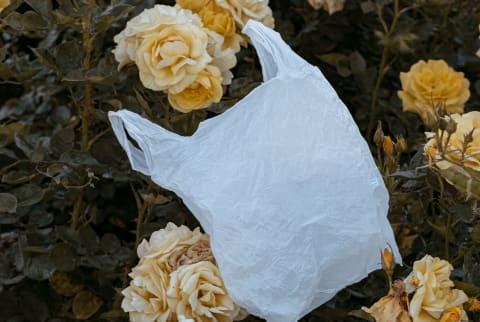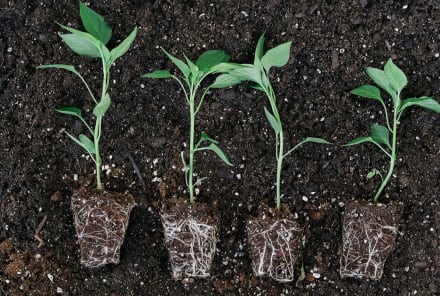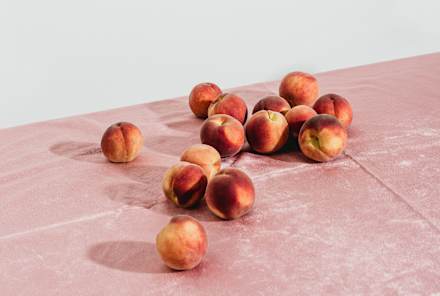Advertisement
How To Recycle (& Reuse) Plastic Bags So They Stay Out Of The Landfill


Plastic was made to last forever, but the sad reality is most of it is used only once before being tossed in the trash. And plastic bags are one of the most prevalent sources of single-use plastic out there.
In this guide, we'll explain what makes these bags so harmful to the environment and share ways to recycle them so they don't end up in the landfill—or worse, in the environment.
How plastic bags harm the planet
We use an estimated one million plastic bags worldwide every minute, and they last an average of just 12 minutes before being thrown away.
Most of these bags are made from either No. 2 high-density polyethylene (HDPE) or No. 4 low-density polyethylene (LDPE) and linear low-density polyethylene (LLDPE). (Grocery and retail shopping bags are typically made of HDPE, whereas plastic films like the ones you find on dry cleaning are made of LDPE or LLDPE.)
These soft plastics are made of fossil fuels, so they emit greenhouse gases at every stage of their life cycle—down to when they're baking in the sun in a landfill, where they can take anywhere from 50 to 1,200 years1 to fully decompose.
Plastic bags not only contribute to climate change; they pollute the planet. These bags are thin and lightweight enough to end up in places they shouldn't be, like our oceans. Floating in the ocean with direct and consistent exposure to sunlight, plastic breaks down into microplastics that are then consumed by animals big and small.
Research2 has found that 60% of fish studied globally contain microplastics, and whales have been discovered dead with stomachs full of plastic waste. Humans also consume microplastics in food and drinking water, and these tiny particles have now been detected in our blood for the first time.
Clearly, the same durability that makes plastic so convenient for consumers makes it extremely hard to break down in the environment. Recycling is one way to keep these bags in circulation for longer so they don't end up as planet-warming pollution.
How plastic recycling works
Most curbside bin programs collect rigid plastics (think water bottles, takeout containers). These plastics are sent to recycling facilities where they are cleaned, processed, and sorted by their type. Each category of plastic is then shredded and cleaned before being melted down and compressed into tiny pellets that can be reused to make new products.
The pellets generated via the recycling process aren't used to create the same plastic item as its original form, notes Stephanie Hicks, materials sourcing manager at Trex, a decking company that uses recycled materials. Instead, they are purchased in bulk and turned into materials like car parts, furniture, or clothing.
Now, you might assume that thin plastic bags can be recycled using the same process. And who could blame you; recycling rules are confusing! A recent survey commissioned by recycling program Covantra revealed that most Americans are guilty of placing things that aren't recyclable in the recycling bin (otherwise known as "wishcycling"). But unfortunately, throwing plastic bags in the bin with hard plastics puts a strain on recycling systems.
"Many people think that since other types of plastic (namely No. 1 and No. 2) are recycled through municipal programs, that means plastic bags are also accepted," says Alex Payne, North American public relations manager at recycling company TerraCycle. "This is false and actually leads to the bags clogging the highly tuned recycling machinery, leading to losses in time, money, and the otherwise recyclable material that the plastic bags become intermingled with."
The extra labor required to fix the machinery and the equipment downtime makes recycling programs less profitable over time.
Ways to recycle plastic bags
While you shouldn't toss bags in with your other recyclables, there are a few other options for keeping them out of landfills and the environment. Here are three to look into:
Take them back to the grocery store
Many grocery and retail stores have designated drop-off receptacles conveniently located near the store entrance. Some receptacles also accept other types of plastic film, including cereal box liners, produce bags, and even dry-cleaning bags. If your local store doesn't have a drop-off program, suggest one and help make a positive change in your community.
Look for a corporate recycling program in your area
Companies like Trex collect their materials through public drop-off bins where consumers can discard their plastic film to be repurposed. They currently have a network of about 32,000 collection locations at stores and distribution centers across the United States and Canada. Check out the full list here to see if there's one in your area.
Use a mail-in recycling program
All of these recycling programs help ensure there is no contamination between recyclable and non-recyclable materials, resulting in a clean recycling stream.
What to do with plastic bags before recycling
Like with common recyclables, Payne notes that plastic bags should be clean and dry and free of any debris, such as receipts, adhesive labels/stickers, etc. before recycling. If bags are not completely clean of food residue, they risk being sent to landfills.
Repurposing plastic bags at home
It's important to remember that Recycling alone will not save the planet. We have to focus first on Reducing and Reusing our bags and treat recycling as the last resort it is intended to be. On the reuse front, there are many ways to give plastic bags a second or even third life at home.
Start by unlearning the notion that they are single-use and continuing to use them for groceries until they can no longer withstand the weight. They can also be used for:
- Lining waste bins
- Covering plants to protect them from frost
- Soaking your showerhead to descale
- Stuffing them into shoes to help hold their shape
- Separating wet stuff from dry in your pool/beach bag
- Storing a few in the car for emergency waste needs
- Keeping your shoes away from your clothes in your suitcase
- Keeping your brushes and rollers from drying out in at-home paint jobs
- Storing small items such as holiday decorations, string lights, etc.
- DIY crafts with kids
How to avoid plastic bags in the first place
Ditching the plastic bags in favor of something reusable is an easy, actionable way to reduce your impact. Not only are cotton or heavier plastic reusable bags more durable and reliable, making your groceries more likely to survive the trip home, but they cut down on plastic litter on land and in our waters.
At home, consider using reusable produce bags and sparing all of that clingy plastic film from going to waste. It should be noted that the production of reusable bags has an environmental footprint as well, so be mindful of how many you continue to add to your collection. (Remember: The most sustainable choice is reusing the bag you already have, regardless of what it is.)
When traveling, pack reusable bags in your carry-on or checked luggage so you can reduce plastic waste on the road. They come in handy for shopping, picnics, and stowing your day-trip essentials too.
Of course, there will be times when you forget your bag and need to accept a plastic one. Don't lose sleep over it! Just remember to bring the plastic bag back to be recycled or put it to good (re)use.
The takeaway
Plastic bags are everywhere, and diverting them from landfills is one way to keep our environment cleaner and healthier. Next time you accept a plastic bag, think about its environmental impact and vow to reuse or recycle it. While you're at it, avoid getting bags in the first place using these tips for avoiding waste in one of the trashiest industries: food delivery.











